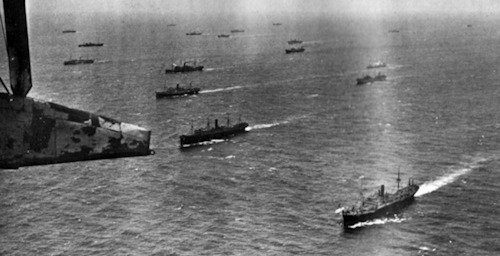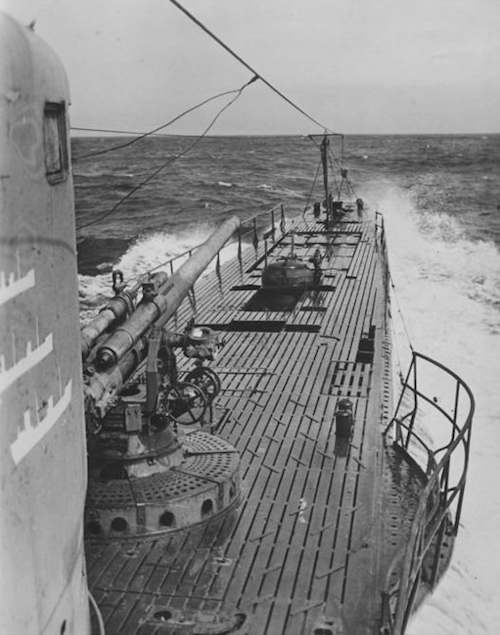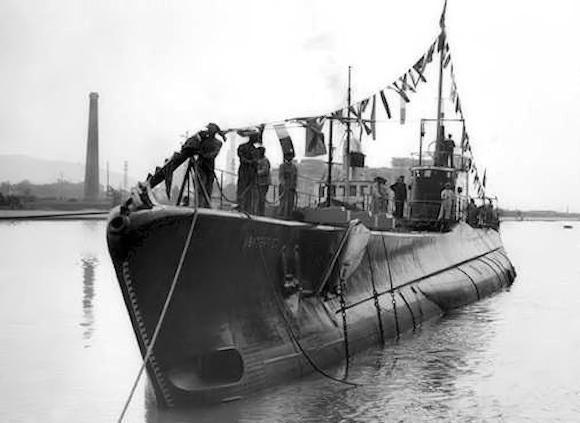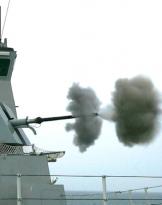The order of 17 January 1941 to suspend the demobilization of the Bordeaux base and to cancel the return of Italian submarines to the Mediterranean was a wise decision. The very positive results achieved later, in the remaining period of the war activity in the Atlantic, did not disappoint expectations (even of the Germans) leading the few Italian submarines to obtain the greatest successes of the war in the ocean, with sinking peaks of merchant ships enemy proportionate to the results achieved by the much more numerous Germanic U-boats.
The submarines of Bordeaux, which up to that moment had operated in the eastern hemisphere of the Atlantic, from the high latitudes south of Iceland, (in very harsh environmental conditions) up to the African equatorial waters of Sierra Leone, amply redeemed the previous disappointing performances .
Once the demobilization order of the Bordeaux base was cancelled, the war activity of the submarines in the Atlantic could be resumed and the new superior commander of BETASOM, the vessel captain Polacchini, worked tenaciously to train the forces at his disposal in the best possible way . First, he advocated for SUPERMARINA to resume officer training sessions at the Tactical School of Gotenhafen, to complete and refine the preparation of the Italian commanders in view of the new missions. She upgraded base services and prepared submarines for long-range, long-lasting operations in tropical waters. Thus began a period – throughout 1942 – of renewed activity and greater possibilities, characterized by the greatest successes of our submarines in the Atlantic.
 Given the small number of boats that remained in Bordeaux (just 11, little more than a squadron), Polacchini quickly became convinced that it would have been absurd to continue fighting the convoys in front of Gibraltar, an area which had by now become prohibitive due to the enormous apparatus of enemy air and naval forces that had concentrated there. Admiral Dönitz had also agreed with the German Navy high command on this as regards his U-boats.
Given the small number of boats that remained in Bordeaux (just 11, little more than a squadron), Polacchini quickly became convinced that it would have been absurd to continue fighting the convoys in front of Gibraltar, an area which had by now become prohibitive due to the enormous apparatus of enemy air and naval forces that had concentrated there. Admiral Dönitz had also agreed with the German Navy high command on this as regards his U-boats.
Polacchini immediately faced the need to launch the Italian submarines as soon as possible in the so-called "racing war" (similar to that carried out successfully by the German corsair ships, which had the isolated enemy merchant shipping as their main objective) along the distant routes, choosing areas where surveillance was less, so as to be able to act by surprise against the enemy.
It was necessary to make the most of the favorable opportunity, deriving from the entry into the war of the United States, bringing the attack to the distant waters of the western hemisphere, near the American coasts, where the merchant traffic, not yet regulated and channeled, led to foresee large possibility of successes to the submarines of BETASOM.
 It was necessary to act with as many units as possible before the adversary had organized his own defences, but the BETASOM commander did not have many boats at his disposal, since of the eleven boats of the XI Submarine Group, still stationed in Bordeaux, only five were in a position to be able to go back to sea within a short time: Da Vinci, Torelli, Morosini (Photo) Finzi e Tazzoli.
It was necessary to act with as many units as possible before the adversary had organized his own defences, but the BETASOM commander did not have many boats at his disposal, since of the eleven boats of the XI Submarine Group, still stationed in Bordeaux, only five were in a position to be able to go back to sea within a short time: Da Vinci, Torelli, Morosini (Photo) Finzi e Tazzoli.
Of the other six submarines, the Bagnolini and Barbarigo (opening photo) they were on a mission in the Azores Islands area; the Calvi it was at work in the arsenal and would not be available before the beginning of the third ten days of February; L'Archimedes and Caps, despite being ready to face the mission, the commander and part of the crews were missing; the Giulianifinally, he was temporarily seconded to Gothenhafen, in the Baltic, at the disposal of the Italian personnel who were training at the local Tactical School German.
For the choice of the most favorable areas of operation to be assigned to the Italian submarines, Polacchini made agreements with Admiral Dönitz, from whom he depended for the operational part. On the instructions of Admiral Antonio Legnani, Polacchini initially tried to convince the Befehlshaber der Unterseeboote, BdU ("German submarine command") to assign the equatorial waters of Capo San Rocco, in Brazil, the focal area of traffic, to the Italian underwater units , crossed by merchant ships traveling in both directions along the west coast of Brazil. In this area one could well hope to be able to take advantage of the surprise attack, since no German submarines had yet gone there.
 However, Polacchini's proposal was not accepted by the BdU for political reasons established by the diplomacy of Berlin, because in that sector the traffic was mainly of Argentine and Brazilian ships, neutral nations with which it was not appropriate to create diplomatic incidents. Then Polacchini, informed that the German submarines would reach the coast of North America, asked to assign the same areas of operation to the Italian submarines as well. But the BdU decided to temporarily assign the BETASOM vessels operating sectors close to the Bahamas and the Antilles, where there was an isolated and intense merchant traffic, mainly made up of oil tankers and steamers transporting metals and foodstuffs to Europe.
However, Polacchini's proposal was not accepted by the BdU for political reasons established by the diplomacy of Berlin, because in that sector the traffic was mainly of Argentine and Brazilian ships, neutral nations with which it was not appropriate to create diplomatic incidents. Then Polacchini, informed that the German submarines would reach the coast of North America, asked to assign the same areas of operation to the Italian submarines as well. But the BdU decided to temporarily assign the BETASOM vessels operating sectors close to the Bahamas and the Antilles, where there was an isolated and intense merchant traffic, mainly made up of oil tankers and steamers transporting metals and foodstuffs to Europe.
Therefore, Polacchini prepared to send the five submarines, currently available, to the chosen areas, about 3.500 miles away from Bordeaux. Calculating the return route and the stay in the area for at least two weeks, from the study of the fuel consumption recorded in the previous missions and of the overloads foreseen up to then, it appeared clear to the BETASOM commander that with the normal naphtha supplies only the Tazzoli and Finzi they could operate with some margin in the distant waters of Central America. The other three smaller submarines could only have done so by increasing their overload, or by supplying at sea.
The largest Italian submarines were subjected to all possible adjustments to make them suitable for war missions in distant waters. The fuel overload was increased to the maximum, reducing "the thrust reserves to the minimum permitted by seaworthiness" – recalls Polacchini – using some immersion and compensation tanks, which were necessary to adjust the immersion weight, for naphtha deposits, and hence the buoyancy and balance ability of submarines. These measures, weighing down a lot and lowering the waterline of the hull, especially at the stern, created problems of stability and safety, which however would have returned to almost normal during navigation with the gradual consumption of the oil on board.
 The five boats were overloaded with fuel, winter and summer lubricating oil, spare parts for the engines, torpedoes and artillery shells. For the well-being of his men, Polacchini also wanted food supplies to be doubled, adding to the normal war assignments everything that was possible to find in Bordeaux, on the local market: frozen meat, sausages, vegetables and fruit, with an availability for consumption for 70 days.
The five boats were overloaded with fuel, winter and summer lubricating oil, spare parts for the engines, torpedoes and artillery shells. For the well-being of his men, Polacchini also wanted food supplies to be doubled, adding to the normal war assignments everything that was possible to find in Bordeaux, on the local market: frozen meat, sausages, vegetables and fruit, with an availability for consumption for 70 days.
Thus overloaded, the submarines were started from BETASOM with a thrust reserve reduced to 6-7% and in some cases even to 4% (while the minimum reserve for all Navies was 10-11%), and if it was possible they were refueled on their outward route by those units on the return route which, having already exhausted torpedoes, had surplus fuel for the return. Furthermore, to allow the commanders to operate without the excessive concern of running out of naphtha, it was decided, as a precaution, to keep the submarine ready in port Archimedes to carry out any naphtha supplies to boats on the return route that may have requested it. not having theArchimedes a commander, under his command the frigate captain Giuseppe Caridi, chief of staff of the Atlantic base, was temporarily assigned for the mission.
Furthermore, all the instructions on the routes to be followed while remaining south of the Azores and the speeds to be maintained in order to reduce fuel consumption as much as possible while crossing the Atlantic Ocean were given to the commanders and naval engineers.
Thanks to this careful planning and organization, the Italian boats managed to carry out war missions lasting over two months, and the three major units (Calvi, Tazzoli e Finzi) even for three months, reaching the coasts of the United States, the Caribbean Sea and even the coasts of Brazil, Argentina and Equatorial Africa, chasing isolated targets.

Read: "BETASOM base preparations to operate in the Western Atlantic (part two)"
Photo: Marina Militare / web / Narodowe Archiwum Cyfrowe
(article originally published on https://www.ocean4future.org)












